Analyzing real-world data (RWD) in pharmaceutical marketing has the power to unearth hidden trends and insights into the overall prescription landscape. However, accessing and compiling this data tends to be a resource-intensive process. This case study explores how PurpleLab’s Prescription Measurement Report empowered the marketing agency Deerfield to harness RWD insights effectively.
The Client
Deerfield, a leading medical and pharmaceutical marketing agency, has worked with over 120 brands across 24 therapeutic categories, aiding in the launch of 35 products. It partners with clients throughout their entire branding journey, from planning and strategy to executing diverse marketing actions — including events, visual identity, digital content creation, campaigns, personal and nonpersonal customer engagement, media planning, data analysis, and more.
The Problem
Knowing that a one-size-fits-all approach doesn’t cut it in the fiercely competitive pharmaceutical marketing landscape, Deerfield wanted to create value for its clients through data-backed insights. According to Bob Caprara, Chief Data Scientist at Deerfield Agency, the firm’s overarching aim is to offer hyper-personalized services to help clients optimize their marketing campaigns and ensure precise targeting.
Having access to prescription data is table stakes in advertising planning and strategy, but Deerfield wanted to unlock deeper insights into the landscape of prescription drugs to work out where, when and how its clients’ advertising and marketing dollars would best be spent.
To get a full picture, they needed insights into the patient journey, encompassing diagnosis, medical procedures, and prescription data. Furthermore, they would need to understand which providers are most active, both at an individual healthcare provider (HCP) and medical facility/practice level.
The challenge is that these insights tend to be scattered across multiple data sources. Pulling it all together and making sense of it is a massive drain on time and resources. Often, by the time effective insights have been garnered, the information may already be out of date.
The Solution
Deerfield opted for PurpleLab’s Prescription Measurement Report in order to unearth hidden market trends and insights that would inform their clients’ advertising strategies.
Leveraging PurpleLab’s comprehensive database of approximately 5.5 billion healthcare claims, Prescription Measurement Report enabled Deerfield to conduct in-depth analyses and uncover actionable insights at a fraction of the time of traditional data analysis methods.
By streamlining data collection and analysis, PurpleLab empowered Deerfield with a bird’s eye view of the factors affecting pharmaceutical sales in specific therapeutic categories, so that they could focus on developing tailored strategies for each client.
The Results
Thanks to PurpleLab’s Prescription Measurement Report, Deerfield unlocked diverse insights for specific clients.
Improved audience segmentation
Deerfield used PurpleLab’s platform to help a bladder cancer pharmaceutical client identify its target providers. Prescription Measurement Report not only identified 134,000 individual HCPs who submitted medical claims for bladder cancer, but also revealed that 60% of these claims originated from just 22,000 of these HCPs.
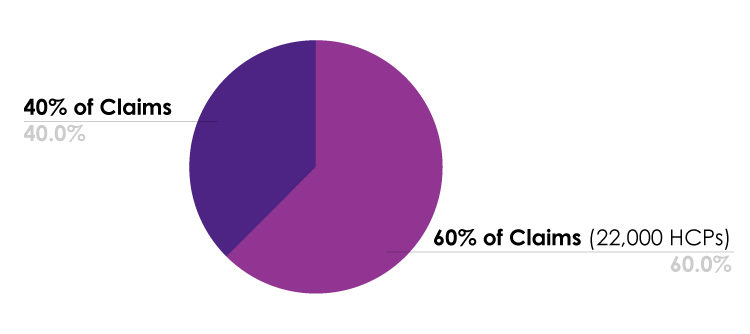
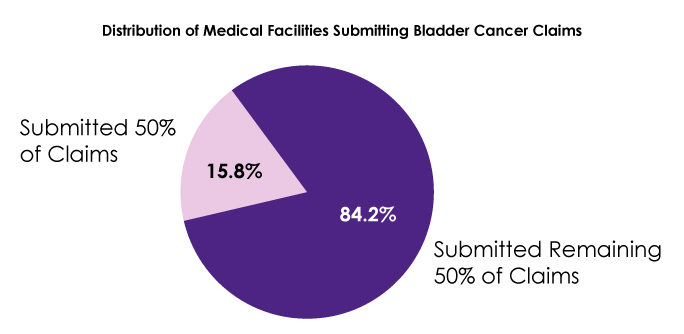
In the same way, they uncovered that approximately 300 medical facilities (out of a total of more than 1,900) submitted 50% of bladder cancer claims. Examining the previous 12 months of prescription data revealed 200 high-value prescribers who distributed their prescribing between treatments.
With this data, Deerfield was able to uncover variations that may not have been obvious if it had remained scattered across different sources. Having this information at their fingertips enabled Deerfield to identify the key providers driving business for its client, and with this, it was able to develop a much more tailored, optimized, and truly data-driven marketing strategy.
Identifying targets for non-personal promotion
Deerfield used PurpleLab data to better understand the landscape of porphyria diagnosis when responding to an RFP for a brand in the porphyria space. They identified 1,154 HCPs who diagnosed 46,905 patients and 25 group practices that diagnosed 96,558 patients in the past year. They focused on EPP, the most common type of porphyria in children, pinpointing a hotspot of EPP diagnosis by pediatricians in the Northeastern US.
With this information, they were able to map out a data-backed marketing optimization strategy, with additional advertising resources allocated to diagnosis hotspots. Most importantly, having quick and up-to-date access to this data meant that Deerfield was able to respond to the RFP quickly and provide insights into the porphyria diagnosis landscape.
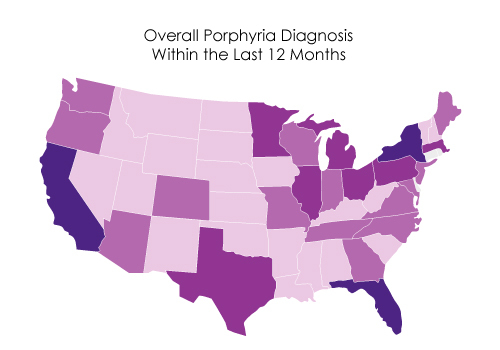
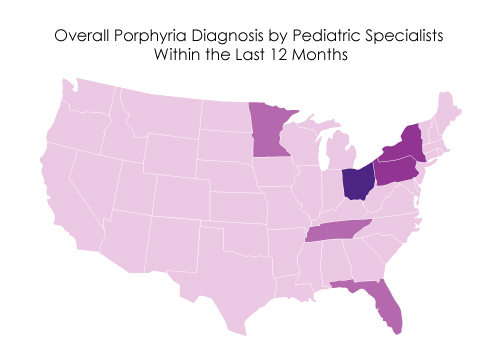
Regional and geographical optimization
For a client in the eczema space, Deerfield conducted an analysis aimed at uncovering insights into the national seasonal variation in prescribing practices for eczema. The analysis evaluated the prescribing patterns of a medication indicated for mild to moderate eczema across different states to observe how prescription activity varied regionally and monthly.
PurpleLab data revealed notable geographical and seasonal variations in eczema medication prescriptions.
From these insights, they were able to develop a tailored marketing plan, delineating which regions of the country should be prioritized at different times of the year. Specifically, they concentrated efforts on the Northeast and Southeast regions of the country during December, January, and February, aligning with periods of heightened prescription activity as indicated by the data.
During March, April, and May, resources were evenly distributed across the nation. June, July, and August saw a focus on the Midwest and central regions, and in September, October, and November, attention shifted to the Southeast and Northwest.
This strategic allocation of marketing resources ensured a targeted approach to reaching healthcare providers and patients when they were most likely to be considering treatment options for eczema. By aligning marketing efforts with the observed seasonal variations in prescribing patterns, the client maximized their impact and efficiency, ultimately leading to increased awareness and uptake of their medication in key markets.
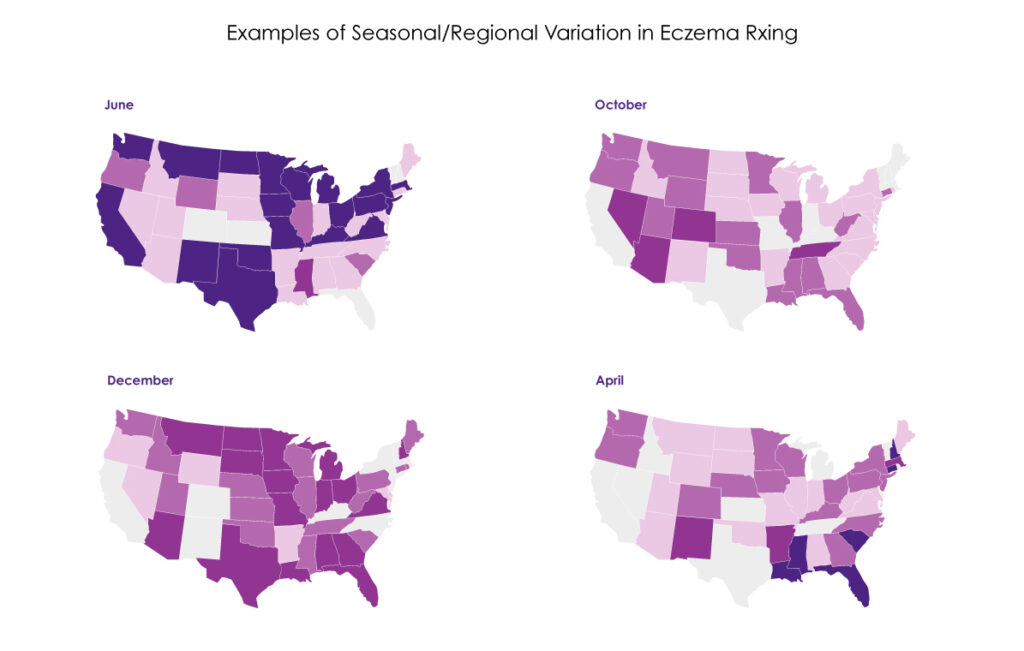

Differentiation between managed care and personal promotions
One client of Deerfield’s was concerned about the underperformance of a recently launched drug. Deerfield used PurpleLab data to perform a diagnostic analysis of the full prescription landscape. Ultimately, they discovered that there had been a decrease in prescriptions for all brand alternatives/generics due to a rise in claim rejections and reversals.
This analysis indicated that the marketing campaign itself was not the cause of the drug’s failure to meet prescription targets, and helped the marketing team pinpoint the true external culprit. They were therefore able to save resources by avoiding unnecessary campaign adjustments.
This case study highlights the diverse applications of data-driven decision-making in pharmaceutical advertising. Through PurpleLab’s partnership, Deerfield transformed its approach to healthcare marketing by leveraging real-world data insights, enabling it to tailor strategies and provide enhanced value to its clients.